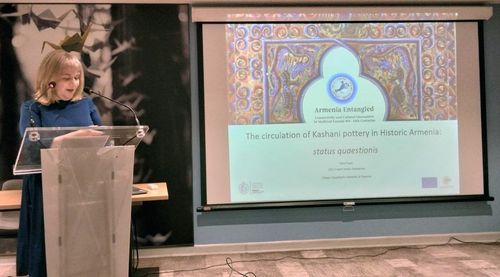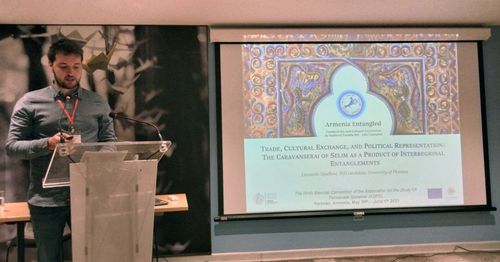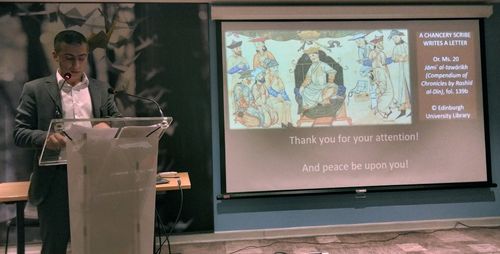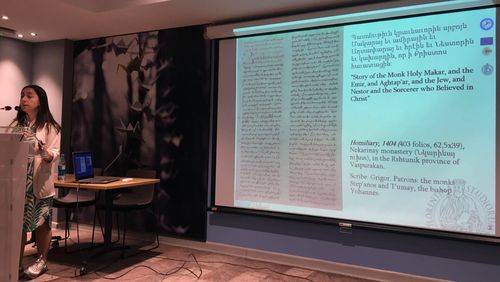Activities ArmEn at the Convention of the Association for the Study of Persianate Societies
ArmEn team members at the Ninth Biennial Convention of the Association for the Study
of Persianate Societies (May 30-June 3, 2023, Yerevan, Armenia)
During the year 2023, ArmEn team members have actively participated in a number of conferences and workshops presenting the results of their research within the ERC project. Among them was the Ninth Biennial Convention of the Association for the Study of Persianate Societies (ASPS) which took place in Yerevan, Armenia on 30 May - 3 June. The conference was co-organised and hosted by the Institute of Oriental Studies of the Russian-Armenian (Slavonic) University, and the Institute of Archaeology and Ethnography of the National Academy of Sciences of the Republic of Armenia. Over four days, more than 150 scholars from 21 countries presented papers on a wide range of topics, including history, literature, archaeology, religion, art, etc.
ArmEn project had a separate panel entitled “Medieval Armenia Entangled (Result of the ERC project ArmEn)”, organised by ArmEn PI Zaroui Pogossian and chaired by ArmEn associate member Alison Vacca from Columbia University, New York. The panel covered topics from textual and archaeological studies.
Elisa Pruno’s presentation at this conference, “The circulation of Kashani pottery in Historic Armenia: status quaestionis”, focused on the circulation of the Kashani pottery, its production, and its soci-economic value in different contexts. Kashan appears to have been a major site for the manufacture of these fine wares between the 1170s and 1220s (565-620s H.) as well as in the later 13th and early 14th centuries, attested by this very term which is used in Arabic and Persian sources to designate glazed tilework. According to various publications Kashani artifacts have been found in such Armenian sites as Dvin, Mesamor, Garni, Etchmiadzin, Tiknuni, and Eghvard. Excavations conducted in Dvin by the Armenian-Italian team has brought to light other fragments of this pottery in stratigraphically excavated contexts, which will allow us to offer more specific chronology of their presence in Armenia.

Leonardo Squilloni presented a paper entitled “Trade, Cultural Exchanges, and Political Representation: the Caravanserai of Selim as a product of interregional entanglements”. The main object of the paper was the Caravansarai of Selim, or the Ōrbelean Caravansarai, traditionally dated to 1332. Located at an isolated mountain pass, on the northern edge of the rural Vayots‘ Dzor region (Armenia), the caravansarai was commissioned by the Ōrbelean nobleman Cesar. Squilloni provided details on the results of a light archaeological analyses carried out on the Selim caravanserai, started as part of The Making of the Silk Road in Armenia project (leader prof. Michele Nucciotti) and continued under the auspices of the ERC Consolidator Grant Armenia Entangled. Squilloni showed that the caravanserai was a multifunctional building, with an economic and political significance, in addition to its basic use as shelter. According to him, the decorative apparatus and the two inscriptions preserved (one in Armenian and one in Persian) reflect the relationship between the Ōrbeleans and the Mongol Ilkhanate court. Although the Ōrbeleans were subjects of the Ilkhans, de facto they acted as territorial lords in their rural domains. This is visible in the economic effort of the Ōrbeleans when establishing such buildings, which intended to link a rural area (Vayots‘ Dzor) to medium and large-scale trade routes.

Gagik Danielyan's talk, “Letters, Envoys, and Interpreters: Diplomatic Correspondence between the Mongol Ilkhans and the Kings of Cilician Armenia”, was devoted to an important 14th century source, Dastūr al-kātibfītaʿyīn al-marātib, a chancellery handbook written in Persian by Muḥammad ibn Hindušāh Naḫğawānī (d. 1376). The manual gives us an idea about the protocol of diplomatic correspondence between the ruling authorities of the Mongol Ilkhanate of Iran and the Armenian kings of Cilicia, as well as the Armenian catholicoi and clergy. G. Danielyan also addressed several interesting reports from medieval sources on Christian, including Armenian, scribes, envoys and interpreters employed by the Ilkhanid court in its contacts with Cilician Armenia and the Latin world.

Armine Melkonyan, in her paper “The Persian Emir Abdlay in an Armenian Interreligious Disputation” presented the text (entitled “Story of the Monk Holy Makar, and the Emir, and Aghtap‘ar, and the Jew, and Nestor and the Sorcerer who Believed in Christ” ) discovered in an Armenian Homiliary copied in 1404 in Nkarinay monastery (in historical Vaspurakan, south of Lake Van). The talk focused on the portrayal of the Persian Emir Abdlay (in some examples Abdlaziz), who played a key role in the Story: he created the scenario, invited the disputing figures, raised the main issues around which the disputation unfolded (almost the entire text is set up as a debate, a question-and-answer between the monk Makar on the one hand, and emir Abdlay, an anonymous Jew, a Nestorian, and a sorcerer on the other). Armine touched upon the historical events and figures mentioned in the text and provided some comments on the satire employed in the text.

Alexandra Cuffel’s paper entitled “Trade, Migration and Artisanal Imitation between Egypt, Armenia, Georgia and Iran: Evidence from the Cairo Geniza”, was included in the panel Late Antique and Medieval Geographies in the Archive. Dr. Cuffel presented evidence from the Cairo Geniza of extensive Jewish travel and trading activities along the main trade routes in Cilicia and Anatolia and to Iran, and even to Dvin from the 9 th century through the Seljuk era. She also showed that colonies of Jewish artisans from the areas designated in the modern day as Iran and Iraq settled in Palestine and Egypt and set up workshops there.




